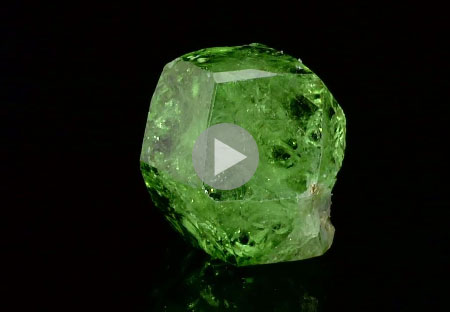
2015.2 | 2015.1 | 2014.2 | 2014.1
2013.2 | 2013.1 | 2012.2 | 2012.1 | 2011.2 | 2011.1 | 2010.2 | 2010.1
2009.2 | 2009.1 | 2008.2 | 2008.1 | 2007.2 | 2007.1 | 2006
January – June 2012
- June Newsletter – May 31
- April Newsletter – April 3
- February Newsletter – February 1
June 2012 Newsletter
In this edition of Pala Mineralis we feature goodies from a recent trip to Tanzania, and a blog entry from mining in our own back yard. Pala Presents the continuation of Kyaw Thu’s dissertation on Mogok, and Part II of the Sickler Family story by Peter Bancroft. We look forward to the Sainte-Marie show and look back at the Sinkankas Symposium. A new look for Lapis, a new tip from Forbes, and a new waterfront warning.
Shows and Exhibitions
Pala International News
Mineral and Mineralogy News
Industry News
Pala Presents
- The Igneous Rocks of the Mogok Stone Tract
Chapters V and VI of a PhD Dissertation by Kyaw Thu - The Sickler Family: Historic San Diego County Gemstone Miners – Pt. II
A reprint by Peter Bancroft
Shows and Exhibitions
Sainte-Marie-aux-Mines: June 21–24, 2012
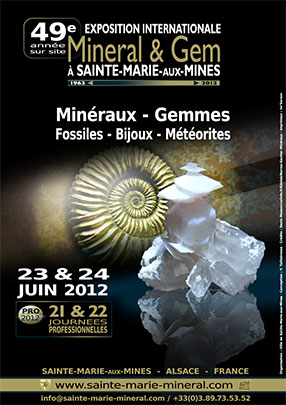 |
The Sainte-Marie-aux-Mines show has been through some changes since its inauguration in 1962. Then it was a small, local affair—a “day of mines.” Two years later the fair was entitled “Cailloux” (stones) and it attracted a regional audience. By 1966 it had become an “International fair of Minerals, Gems and Fossils.” While it originally was attended only by professionals—and professionals still enjoy their trade-only days—two days are now open to the general public. The show now attracts about 24,000 visitors and nearly a thousand exhibitors.
As we have noted before, 2012 was to see a major change in the show—a move to nearby Colmar. That was scrapped when other organizers decided to stay behind. So, at least for now, the show remains in the picturesque Alsatian village of Sainte-Marie-aux-Mines.
To get a taste, see:
- The Larsons’ report for the 2010 show, reprinted from The Mineralogical Record
- Will Larson’s solo report on Day 1 of the show
This year, Bill, Will, and Carl Larson will attend the show along with friend and fellow gem dealer Mark Kaufman. They will follow that with a business trip to the gemstone center of Idar-Oberstein in Germany.
What: Mineral & Gem à Sainte-Marie-aux-Mines
When: June 21–24, 2012
Where: Sainte-Marie-aux-Mines, France
We look forward to seeing you there. [back to top]
Sinkankas Symposium Papers Available
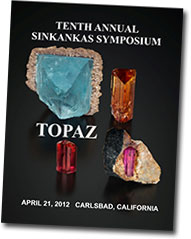 |
The tenth annual symposium in honor of John Sinkankas took place April 21 at the GIA (Gemological Institute of America) in Carlsbad, CA. The theme of the symposium was “Topaz.” Co-hosted by GIA and the San Diego Mineral and Gem Society, the event was attended by more than 125 people.
The printed papers presented at the symposium are now available for purchase from the symposium website. The specifications of the publication follow.
Photographs by Mia Dixon, John Koivula, Skip Simmons, Orasa Weldon and Robert Weldon
Table of Contents
- Acknowledgments 4
- Speaker and Author Biographies 5
- Papers –
- Dr. D.B. Hoover, The Historical Transmutation of Topaz 11
- Dr. Skip Simmons, Topaz Mineralogy 21
- Dr. James A. Shigley, Topaz Geology and Localities 31
- John Sinkankas, TOPAZ From Gemstones of North America 41
- John Koivula, The MicroWorld of Topaz 55
- Si and Ann Frazier, Topaz Words and Their Surrogates 63
Availability: April 21, 2012
Cost: USD $20.00 + shipping (varies according to shipping options and destination)
Specifications: 8/5" x 11"; soft cover, 88p., 25 col. pl., 1 B&W pl., 9 diag. and tables
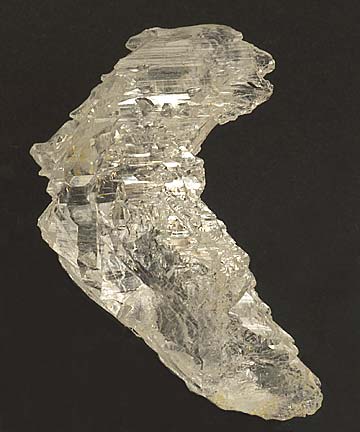 |
| Topaz? This is a unique formation of gemmy and lustrous topaz from Mina de Francisco, Teófilo Otoni, Brazil. Inventory #9486. (Photo: John McLean) |
A brief recap of the symposium and speaker biographies are available at the website.
Still available are:
- Ninth Annual Sinkankas Symposium – Diamond, 2 Volumes
- The Birthday Book of Diamonds by Harold and Erica Van Pelt
- Eighth Annual Sinkankas Symposium – Gem Feldspars
See the website for tables of contents. [back to top]
Pala International News
Pala’s Featured Specimens: Tanzanite from Arusha, Tanzania
This time we feature unusual fan-shaped crystals. These tanzanites have some of the most fun crystallography, which is why we had to bring them home from Tanzania on our recent trip there!
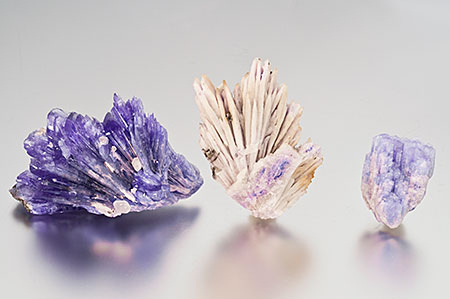 |
| Fan fanatic. Tanzanite from Mererani (Merelani), Arusha Region, Tanzania. Left to right, 6.5 x 3.7 x 3.2 cm, 5.2 x 4 x 2.1 cm, and 3 x 2.4 x 2.7 cm. Click to enlarge. Prices available upon request. (Photo: Mia Dixon) |
Bill and Will Larson attended the Arusha International Gem, Jewelry and Minerals Fair in Tanzania in April. Time allowing, Will Larson plans a report on the show for our colored gemstone e-newsltter, Palagems Reflective Index, which should go out on Flag Day, June 14.
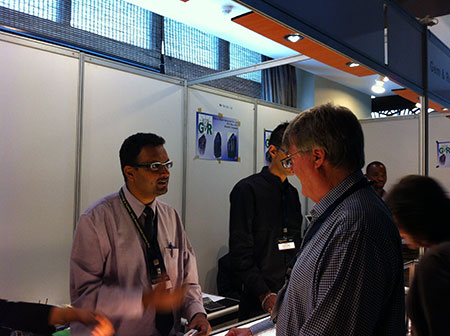 |
| Bill Larson, right, talks tanzanite with a dealer at the show. (Photo: Will Larson) |
New on the Blog
Things are looking very promising at the Mountain Lily Mine. A couple of weeks ago, Pala’s Jason Stephenson accompanied John McLean and Ben Castillo as they met up with Casey Jones to look at the positioning of the pegmatite at the mine. The heavily picked-through tailings produced reassuring results. Read about it in “Of Bluffs and Bees: The Mountain Lily Mine” on the blog.
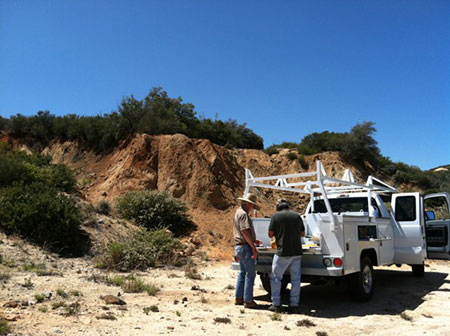 |
| John McLean and Ben Castillo look over the mineral samples collected throughout the day. Notice the weathered bluff in the background where the pegmatite lies in wait. (Photo: Jason Stephenson) |
[back to top]
Mineral and Mineralogy News
Lapis Website Gets Face-lift
Neu!
 |
| Featured on the website is this book published in conjunction with Arizona’s centennial. The book was reviewed in the Spring 2012 edition of the Journal of the Geo-Literary Society. Membership info here. |
For nearly 40 years, the German-language mineral magazine, Lapis, has offered world-class information and photographs of museum-class specimens. Last month, the magazine launched a new website (translated here).
Currently, several events are highlighted, such as an annual celebration this summer that will anticipate in September the 850th anniversary of the mining town of Freiberg in Saxony. The town is home to the Technische Universität Bergakademie Freiberg (Freiberg University of Mining and Technology), the oldest mining university in the world, having been founded in 1765. Although mining in the area declined decades ago, the town features a mining museum. Festivals feature miner and ironworker guilds and a miner music corps.
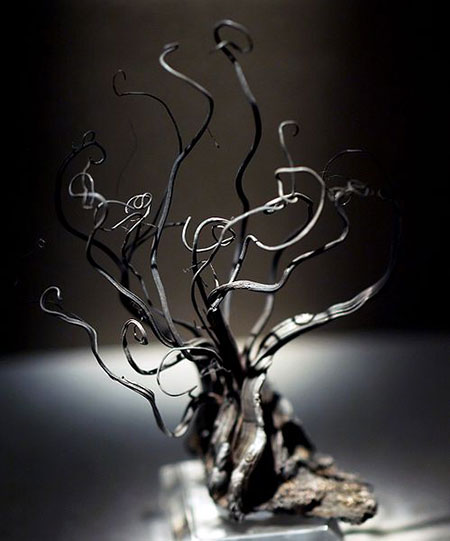 |
| Silver. Isometric native element, Freiberg District, Erzgebirge Saxony, Germany. This image of a specimen at the Houston Museum of Natural Science, was contributed as part of the Wikipedia Loves Art project in February 2009. See more specimens by original photographer sulla55. |
The Lapis website also features several photo galleries: a 2011 photo competition and scenes from the 2011 shows in Munich, Bramberg and Sainte-Marie-aux-Mines. Of course, there are opportunities to obtain back issues, books (including a “flea market”) and tools. The show calendar is extensive. And the mineral marketplace, mineralien.de, is translated into English. [back to top]
Hot Rocks
Beach-goer burned by rocks collected by her children
On May 12, a Saturday stroll at San Onofre State Beach in California ended in two surgeries for an Orange County woman whose cargo shorts caught on fire. The culprit: rocks collected by her children. After returning home, the rocks ignited, burning the woman, Lyn Hiner, setting off a fire alarm and burning the wood floor. The injury required two skin-graft surgeries.
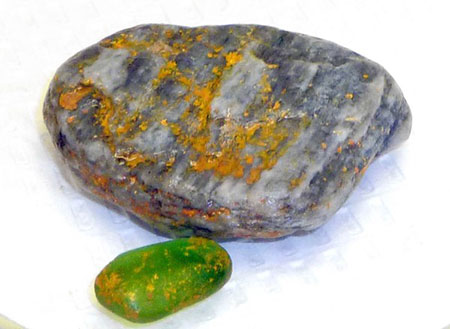 |
| Inflammable material. These two rocks, out of seven collected at the beach, had phosphorus on them, leading to a sizzling situation. The victim’s husband, Rob Hiner, said on Good Morning America that the flame was intense and bright. (Photo: Orange County Health Care Agency) |
When tested locally, the rocks were found to contain “a phosphorus substance,” which can be very flammable. As of a week later, how phosphorus would contaminate the rocks was still baffling scientists, according to a Los Angeles Times blog. The rocks have been sent to a state lab for more testing. [back to top]
Industry News
Fiscal Responsibility: Forbes on Minerals
Two weeks ago, Forbes posted a personal finance item by Deborah L. Jacobs, who covers “personal finance for baby boomers.” The article, intriguingly, was titled “If Facebook Delivers (Or Disappoints), Try Minerals.” In other words, if the IPO is a boom, use some of the returns on investing in mineral specimens. If the roller-coaster leaves you dizzy, cash out and… invest in mineral specimens.
The article quotes dealer James Walker as saying that some of the finest specimens of tourmaline, rhodochrosite and gold are bringing in five times what they did just five years ago.
 |
| Investment property. This tanzanite on matrix is one of the old historical specimens found in the original discoveries in the Merelani Hills. Natural, with no treatment. Inventory #14163. (Photo: John McLean) |
Some of the specimens that Jacobs discusses are illustrated in a slide show, such as a complex calcite scepters on amethyst, and a Red Cloud Mine wulfenite that may be familiar to frequenters of the Tucson show. [back to top]
Pala Presents
The Igneous Rocks of the Mogok Stone Tract
Chapters V and VI of a PhD Dissertation by Kyaw Thu
With Pala Presents, we offer selections from the library of Pala International’s Bill Larson, who will share with us some of the wealth of information in the realm of minerals and mineralogy.
In this installment, we present Chapters V and VI of Kyaw Thu’s 2007 PhD dissertation, which survey the petrogenesis and geochronology of the Mogok Stone Tract’s igneous rocks.
Five major sections are devoted to petrogenesis.
- Origin of the Granitic Rocks
- Origin of Augite-biotite Granite
- Origin of Leucogranite
- Genetic Types of the Granitic Rocks of the Area
- Origin of Alkaline Rocks
- Origin of Nepheline Syenite
- Origin of Urtite Series
- Origin of Ultramafic Rocks
- Emplacement and Depth of Intrusions
- Metamorphic and Igneous Rocks History of the Area
Geochronology is discussed in four sections. Note that some of the figures in this section have illegible content.
- Analytical Methods
- Data Interpretation
- Geochronology of Igneous Rocks of Mogok Area
- Age of Mogok Metamorphism
Our next installment will conclude the dissertation, with Chapter VII Economic Geology, Chapter VIII Summary and Conclusions, and Appendices.
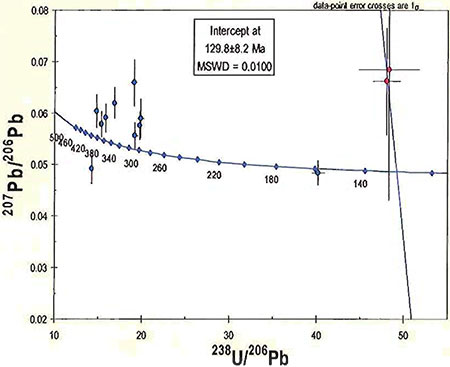 |
| Figure 6.4. The concordia plot diagram of radiometric dating of augite-biotite granite (A-2) by LA ICP-MS technique. |
[back to top]
The Sickler Family: Historic San Diego
County Gemstone Miners
Part II of IV by Peter Bancroft
In the second part of Peter Bancroft’s profile of the Sickler family of San Diego County, the author describes how Marion and his brother William put down roots by building a grist mill, fitting it with millstones from France, in the late 1880s. Hearing of gemstone discoveries by local Native Americans, the Sicklers began prospecting. Bancroft follows the developments of the turn-of-the-century claims made by the family members. Marion’s White Queen Mine, for instance, produced pink tourmaline, large crystals of quartz, morganite crystals, and what would be known as kunzite.
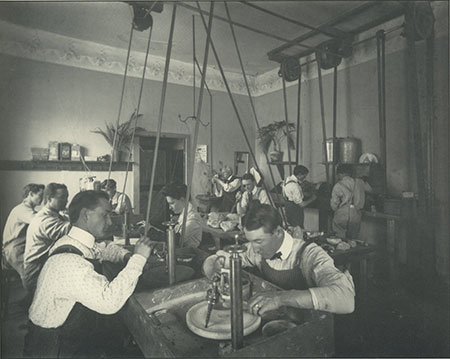 |
| Gem stone cutting. This 1906 picture probably taken at the San Diego Jewelry Co., 836 Fifth St., in the “Gaslight District” of downtown San Diego. Courtesy San Diego Historical Society, Ticor Collection. |
To promote his mines, Marion built a replica of a gem mine for the 1915 Panama-California Exposition in San Diego’s Balboa Park. The mines, Bancroft notes, were really only break-even ventures. But the Sicklers were hooked on the effort nonetheless.
Read Part II of “The Sickler Family: Historic San Diego County Gemstone Miners” by Peter Bancroft.
From CIBJO Tourmaline Day
CIBJO, the World Jewellery Confederation, issued a brief summary of Tourmaline Day, a mini-conference held May 19 in conjunction with the CIBJO Congress in Vicenza, Italy. According to the summary, abstracts of the presentation were to be posted here, but as of e-press time, they had not been.
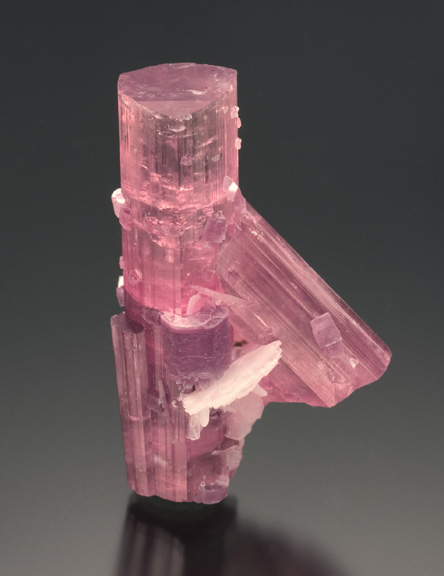 |
| Multiplex. This was our featured specimen for February 2008, a result of Pala’s 20-year mining effort at San Diego County’s Himalaya Mine. It’s composed of two interlocking tourmaline crystals; where the two conjoin, it sports a 9-mm lavender lepidolite sitting on a plate of white cleavlandite. (Photo: Wimon Manorotkul) |
[back to top]
— End June Newsletter • Published 5/31/12 —
April 2012 Newsletter
In this edition of Pala Mineralis we offer a cherry-blossom-pink rhodochrosite specimen from Peru, which is entering its autumn as we bud into spring. And a new trade organization offers charter membership. We take another look at vines, mines and emeraqua; an interesting look at mining family; and a last look at All That Glitters. And more…
Shows and Exhibitions
Pala International News
Mineral and Mineralogy News
Industry News
Pala Presents
- The Sickler Family: Historic San Diego County Gemstone Miners
- The Igneous Rocks of the Mogok Stone Tract
Chapter IV of a PhD Dissertation by Kyaw Thu - Emeraqua Follow-up
Shows and Exhibitions
Euro-Mineral, Euro-Gem on Standby
Last summer, the organizers Euro-Mineral and Euro-Gem announced a move from Sainte-Marie-aux-Mines to nearby Colmar. In November, however, Sainte-Marie officials announced that they would mount their own show in the little Alsatian commune. Because the shows were scheduled for the same time in June 2012, exhibitors were placed in a predicament.
No more quandary now: Euro-Mineral and Euro-Gem are cancelled for 2012. A full-time staff of four has been laid off as the show’s producers “go into a sort of stand-by mode.” Read the announcement here.
As we reported earlier, the competing show, in Sainte-Marie-aux-Mines, is scheduled for June 21–24. Visit the website here. [back to top]
Turin Mineral Show: October 4–7, 2012
 |
The 41st Turin International Mineral Show (Euromineralexpo) will be held October 4–7, 2012, at the 1st Pavilion of the Lingotto Fiere Exhibition Center in Turin (Torino). The 4th and 5th will have exhibitor-only hours; the 5th through 7th is open to the public beginning at noon on the 5th.
Visit the show website; look for links in Italian, English and French.
See this report from the 2007 show. [back to top]
Pala International News
Pala’s Featured Specimen: Rhodochrosite from Peru
This month we offer a piece from Peru. This fine rhodochrosite is covered with many rhombohedral crystals that are undamaged. The crystals are a bright and happy pink. For the locality—the Manuelita Mine of Morococha District—this piece is quite special for its size. Turning the piece onto its back reveals the rhombohedral crystals growing on top of botryoidal rhodochrosite, giving it a round shape.
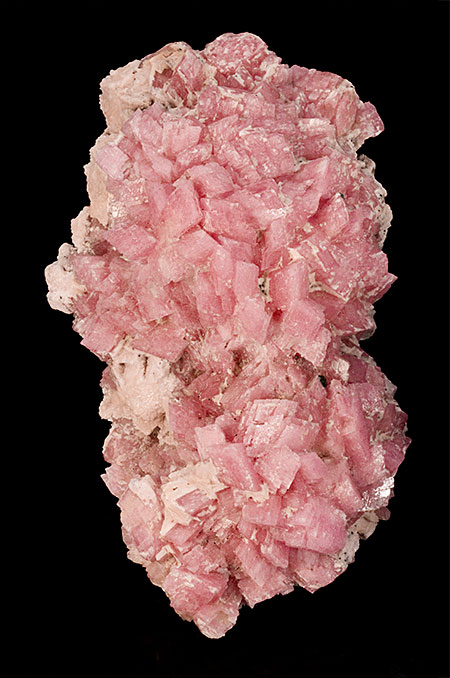 |
| Rhodochrosite from Peru, 11 x 6.5 x 3.5 cm. From the Manuelita Mine, Morococha District, Yuali Province, Junín Department. (Photo: Mia Dixon) |
Mineral and Mineralogy News
Mineral Perspectives: Thumbnails – Volume 2
Collectors reveal a passion for the petite
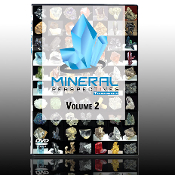 |
Volume 2 of BlueCap Productions’ Mineral Perspectives: Thumbnails is available—a two-hour DVD. The viewer gets a 360-degree look at selected pieces from the collections of Desautels-winner Alex Schauss, Mineralogical Record editor Thomas Moore, and Friends of Mineralogy president Allan Young, along with their personal recollections regarding each specimen. The series is hosted by Jim Houran.
Of course, if you’re a subscriber to Mineralogical Record, you’ve already received a complimentary copy of the DVD with the March–April edition.
Friends of Pala International get a 10% discount on any BlueCap order. Just enter the code palaintl when you’re asked for it while ordering.
Facing the Faceting
As we noted last month in our sister e-publication, Palagems Reflective Index, little-lovers were broken-hearted at the prospect of Australia’s largest pink rough diamond being faceted. It was announced that, following two months of study, the deed would be done by Argyle’s Richard How Kim Kam. As Pala International’s Bill Larson put it when he received the news, “The world’s best thumbnail crystal specimen... sacrificed to make a cut gemstone!” The 12.76-carat crystal was discovered by Australia’s diamond producer Rio Tinto at its Argyle mine, famous for its pink product, which commands 90% of the market. According to the company’s February 21 press release, only 18 polished pinks over 10 carats have been auctioned by Christie’s in its 244 years of existence.
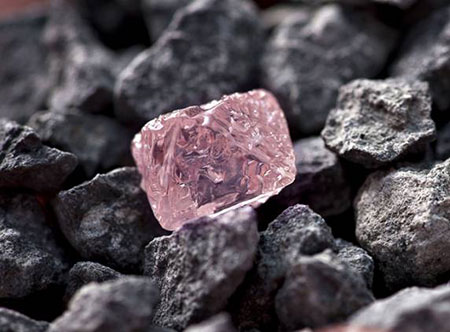 |
| The Argyle Pink Jubilee, in a handout photo provided by Rio Tinto. |
See two more handout photos from Rio Tinto via Agence France-Presse.
In other news about Rio Tinto, it was announced last week that the company is considering offloading its diamond interests. [back to top]
Industry News
Fine Mineral Trade Association
New organization open to trade, collectors, and more
A new organization for the mineral trade has been organized as a result of meetings over the past few years at the Tucson show. The Fine Mineral Trade Association (FMTA) will be incorporated this year as a non-profit education and trade organization “devoted to the promotion of collecting fine mineral specimens as a hobby, a business and as a scientific and educational endeavor,” according to a welcome letter sent to prospective members on March 13. While the organization will not deal with specimen pricing, it will address quality and integrity issues. (For instance, see FMTA Specimen Quality Standards, on the association website.)
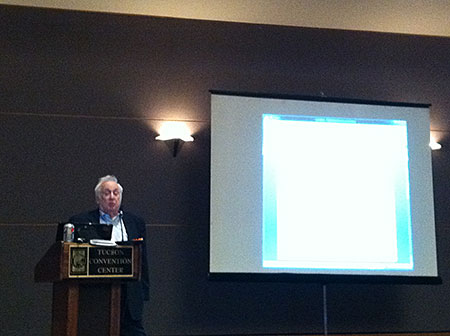 |
| Gene Meieran sets up for the meeting of then-unnamed mineral organization in 2011, in Tucson. Meieran, who began collecting in his father’s Norway in 1949, is the acting CEO of FMTA. (Photo: Bill Larson) |
FMTA is patterning itself after the Antique Tribal Arts Dealers Association, due to the similarity of issues involved in both trade areas. While primarily dealer-driven, FMTA is open to anyone involved or interested in the trade, including collectors, museum curators, academics, appraisers, photographers, clubs and organizations, authors, publishers, and more. Four classes of membership are offered: Full Member (dealers and board members), Associate Member, Museum Curator and Academic, and Junior Member (under age 13).
See the welcome letter and application. For more information, contact Will Larson, Membership Chairman. [back to top]
Coghlan and Ironstone: Of Vines and Mines
Coghlan Vineyard & Jewelers
Last fall, we introduced you to the Coghlan family of Los Olivos, California, with 56 years in the jewelry business and, more recently, a promising production of already-award-winning wines. With Pala International president Bill Larson’s interest in g-juice well documented in our pages, a Tucson tasting, featuring Coghlan varietals named for minerals, was in order. The tasting was hosted by Pala and Wayne A. Thompson Fine Minerals.
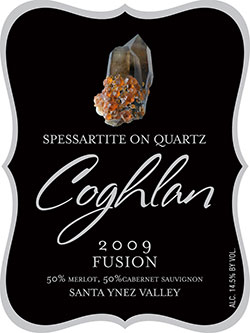 |
| Fusion. Not a varietal, but blend of a Merlot base, crafted by adding small amounts of Cabernet Sauvignon to achieve the 50/50 proportion. The spessartite on quartz struck Eric and Samantha as the perfect specimen to adorn their first blended offering. |
The Coghlans recently rolled out their website with details on all the wines, the business history, a wine club (for out-of-towners), the vineyards and more. We learned that Eric and Samantha Coghlan are in the process of receiving “organic” status certification.
Ironstone Vineyards
Ironstone Vineyards’ story begins eight years earlier, in 1948, with John Kautz, of Lodi, supplying premium grapes to vintners for the next forty years before his family crushed their own, developing the Kautz label, forerunner of Ironstone Vineyards. John, his wife Gail, and their four children are involved in the operation, but they have other interests as well. The production facility is a step back in time, patterned after a 19th century gold stamp mill. Below the tasting room is a music room that houses a rare and functional Robert Morton theatre organ, originally from Sacramento’s Alhambra Theatre. Adjacent to the music room is a 1,560-square-foot culinary center in which chefs conduct demonstrations and classes. The Heritage Museum displays 19th century gold mining artifacts and items from the Native American Miwok people, who populated the area.
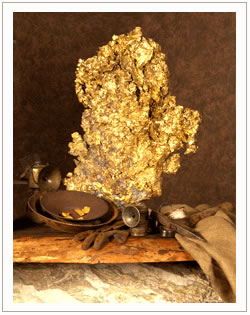 |
| Gold Pocket. This specimen, originally 63 pounds in weight when it was discovered in 1992, is now 19 pounds lighter after spending nearly a year in an acid bath that removed the surrounding matrix. It is 98% pure and is on display in Ironstone’s Heritage Museum. (Photo courtesy of Ironstone Winery) |
The Museum is home to the largest crystalline gold leaf specimen in the world, known at the “Gold Pocket.” This and other gold specimens are on display behind a stone entrance resembling that of a hard rock gold mine. Also within the museum is the Heritage Jewelry Shoppe, which offers custom designs and gold-in-quartz jewelry. Outside, the Ironstone Winery features an amphitheater and lakeside park as well as gardens and gold panning.
Ironstone practices sustainable viticulture, which involves a reduction of water use, creation of healthy soil, and respect for neighboring wildlife. Visit the website here.
Wayne Leicht to Speak on Gold, Circa ’49
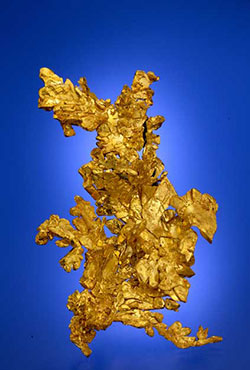 |
SoCal’s Bowers Museum will present Wayne Leicht, world renowned collector and dealer of gold and mineral specimens, in its Distinguished Lecture series, April 21, 2012, 1:30 PM – 2:30 PM.
The presentation, “The Rush for Gold – California’s Treasures Unearthed,” discusses the discovery of gold in 1849 and the beautiful gold specimens he has loaned to the Bowers currently on display in the California Gold exhibit.
The exhibit features the piece at left, from the collection of Dona and Wayne Leicht, photographed by Erica Van Pelt. [back to top]
Pala Presents
The Sickler Family: Historic San Diego
County Gemstone Miners
Part I of IV by Peter Bancroft
With Pala Presents, we offer selections from the library of Pala International’s Bill Larson, who will share with us some of the wealth of information in the realm of minerals and mineralogy.
In his profile of the Sickler Family of San Diego County, Peter Bancroft recalls, as a boy, reading about the discovery of gem crystals that later would be dubbed kunzite. But, of course, the discovery was not made by George Frederick Kunz, the famous mineralogist of Tiffany & Co. fame. It was made by two Southern California boys, Fred and Allan Sickler, who were about the same age as Bancroft when he first read the story.
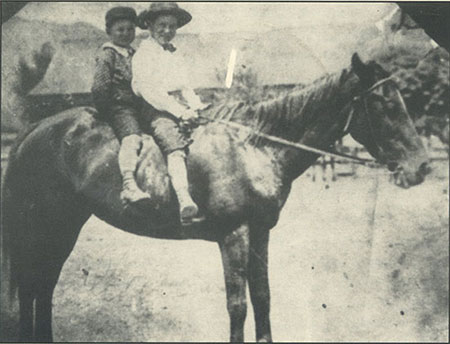 |
| Fred Sr. and Allan Sickler. The two brothers, Fred Sr., and Allan, at Pala Mission, 1894. Courtesy George Ashley. |
Attribution regarding the discovery of kunzite was contentious, as chronicled in Lawrence H. Conklin’s “On Kunz & Kunzite,” and makes for compelling reading. The story Bancroft read as a child certainly captured his imagination, and he couldn’t believe his good fortune at being put in touch with Fred Sickler, Jr., and his wife Vera, when Bancroft paid his respects to another San Diego County icon, the late miner and lapidary artist George Ashley, in October 1991. Through his interviews with the Sicklers, Bancroft was able to give a detailed portrait of a family that Ashley, a friend of Bancroft’s, himself had lost track of, even though Ashley had bought “the old Sickler house.”
Read Part I of “The Sickler Family: Historic San Diego County Gemstone Miners” by Peter Bancroft.
George Ashley Bowls, Kunzite on Display in “All That Glitters…” Thru Sunday
The San Diego Natural History Museum exhibition, “All That Glitters: The Splendor and Science of Gems and Minerals,” includes kunzite specimens and faceted stones, including The Big Kahuna, one of the top kunzite specimens known. From the museum’s own collection are displayed a series of bowls carved by George Ashley, who is mentioned in Peter Bancroft’s article on the Sickler family.
You’ll need to catch the show this week; it ends Sunday.
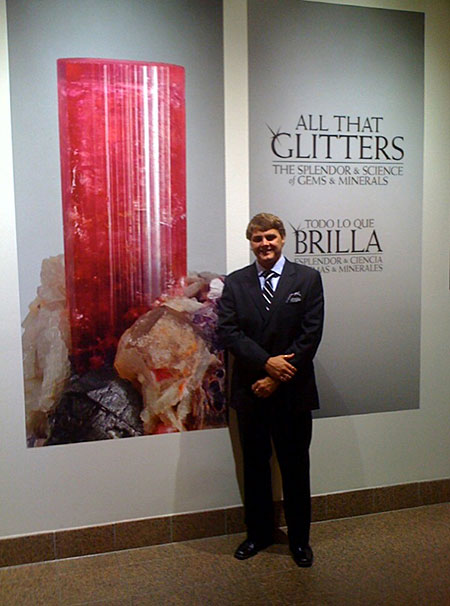 |
| Glitterati. Carl Larson and a poster of his own tourmaline specimen, from the Stewart Lithia Mine in San Diego County. |
[back to top]
The Igneous Rocks of the Mogok Stone Tract
Chapter IV of a PhD Dissertation by Kyaw Thu
In this installment, we present Chapter IV of Kyaw Thu’s 2007 PhD dissertation, which surveys the petrography of the Mogok Stone Tract’s igneous rocks. He discusses this in three sections.
- Analytical Data
- Presentation of the Analytical Data
- Petrogenetic Interpretations, in two sections:
- Nature and Chemical Changes in Igneous Differentiation
- Conditions of the Crystallization of the Igneous Rocks
Our next installment will feature Chapter V Petrogenesis.
 |
| From Figure 4.19. Temperature-differentiation index diagram for the igneous rocks of the area, at 2 kb water pressure (after Piwinskii and Wyllie, 1970). |
[back to top]
Emeraqua Follow-up
Response to the late George Bosshart’s study
Following our publication, via Pala Presents, of George Bosshart’s study of emerald and aquamarine zones in bi-colored, green and blue beryls in February, we received a response from Stuart Wilensky.
I was just reading the article you put up on your web site about Bi-color Emeralds and I thought this would interest you (see attached photo). I sold this piece last year. It was amazing, top half was Aqua and the bottom half Emerald and on matrix! I was told it came from the Swat valley, Pakistan and that a few other single crystals were found as well. It was found about 6 or 7 years ago.
Indeed, it did interest us…
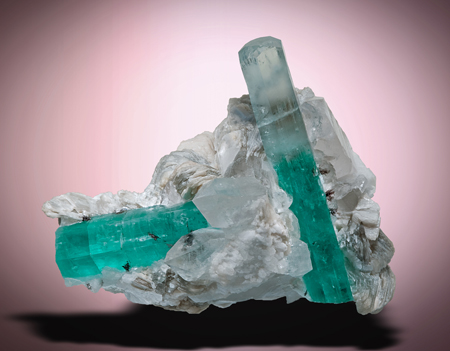 |
| Emeraqua. The perfect visual aid for George Bosshart’s study of bi-colored beryl. (Photo: Stuart Wilensky) |
[back to top]
— End April Newsletter • Published 4/3/12 —
February 2012 Newsletter
In this edition of Pala Mineralis we look at rocks and crystals: impossible, bi-colored, igneous, the subject of books and paintings and documentaries and exhibitions and expeditions—full of wonder.
Shows and Exhibitions
- Tucson Time: January 31 – February 12, 2012
- Gamini Ratnavira—On the Road and Closer to Home
- Dallas 2011 DVD — 2012 Lineup Includes Larson
Pala International News
Mineral and Mineralogy News
- George Bosshart 1943–2012
- George Bosshart on Bi-colored Beryl—“Emeraqua”
- Mineral Impossible: Extraterrestrial Quasicrystal
Pala Presents
- The Igneous Rocks of the Mogok Stone Tract
Chapter III, Parts 1 & 2, of a PhD Dissertation by Kyaw Thu
Shows and Exhibitions
Tucson Time: January 31 – February 12, 2012
We’re looking forward to the world’s greatest gem and mineral show in February. One-stop general information about individual shows can be obtained from the Tucson EZ-Guide.
Pala International will be represented in Tucson as follows. We look forward to seeing our many friends there. Visit the Pala International Show Schedule for future events.
Tucson Tasting
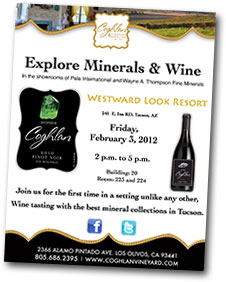 |
The Westward Look Show this year begins with a bang—or, rather, the pop of a cork—as the wines of Coghlan Vineyard & Jewelers will be breathing in the showrooms of Pala International and Wayne A. Thompson Fine Minerals.
During the Denver show last fall, we had the pleasure of sampling the 2009 “Diopside” Pinot Noir, which impressed some judges at last year’s Pinot Noir Summit and Pinot Shootout.
Click the invitation at right for details.
For more on Coghlan, see our write-up from August 2011.
And a Sneak Peek at a Rare Find
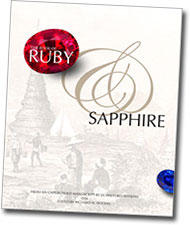 |
At Tucson you’ll likely get a peek at a project dear to the heart of Richard Hughes: The Book of Ruby & Sapphire, From an Unpublished Manuscript by J. F. Halford-Watkins. Such a manuscript, from the pen of Halford-Watkins (?–1937), who died before it could be printed, is remarkable because the writing springs from his more than twenty years of residence in Mogok. The scope is what you’d hope for: history, chemistry and crystallography, physical properties, “enclosures,” sources (Burma and elsewhere), mining—and that’s but half of the book’s pages.
The present volume is the result of more than a decade’s effort by Hughes and his confederates (including Pala’s Bill Larson), and the presentation is a reflection of the singular scholarship exhibited in Halford-Watkins’s text. The book is handsomely augmented by the inclusion of dozens of photographs and illustrations from an array of sources, contemporary, current and in-between. A sweet surprise is the addition of “The Streeter Diaries,” by way of Patrick Streeter, grandson and biographer of George Skelton Streeter, who traveled in 1887 with the first British expedition to Mogok. It was in Patrick’s book that Richard Hughes first learned of Halford-Watkins’s manuscript.
Dr. John Emmett, who urged Hughes to take on the project, apparently found his confidence well-placed, saying that the book “is a rare find—as exquisite as any fine ruby” and that every lover of fine gems will want a copy. It is scheduled for a February 6 release, at Blurb.com.
And Speaking of Books...
GIA (Gemological Institute of America) presents “Tablet to Tablet: Treasured Pages from Past to Present,” an exhibition of more than 26,000 pages from rare books dealing with gems, minerals and natural science. The oldest book included in the show is a 1496 edition of Pliny the Elder’s (23–79 CE) Natural History; the “books” from this encyclopedia on mining and mineralogy, XXXIII–XXXVII, contain some of the most important classical writing on mineralogy and gemology. The exhibit will be open to the public until early this summer.
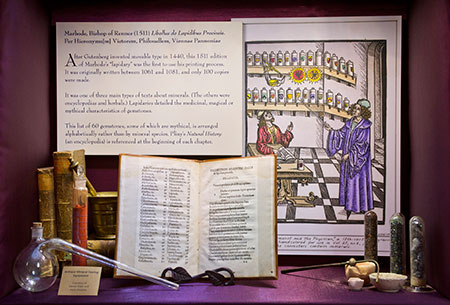 |
| Displayed is the first edition (1511) of Liber de lapidibus by Marbode (1030s–1123), Bishop of Rennes. Marbode composed primarily in verse, this lapidary being no exception; it originally contained 742 lines describing 60 gemstones—some mythical. A Mineralogical Record biography of the poet states that the book actually falls into the area of medical writing, since most of it touts the healing properties of the stones. (Image © GIA) |
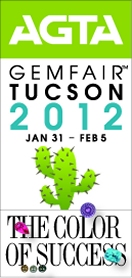 |
AGTA GemFair
Pala joins nearly 100 exhibitors for this annual extravaganza.
Event: AGTA GemFair
When: January 31 – February 5, 2012
Where: Tucson Convention Center
Booth: 1016
The event website now features an interactive floorplan allowing you to see who is exhibiting by area of the convention center.
More than forty free seminars are offered by notables in the world of gemstones and pearls.
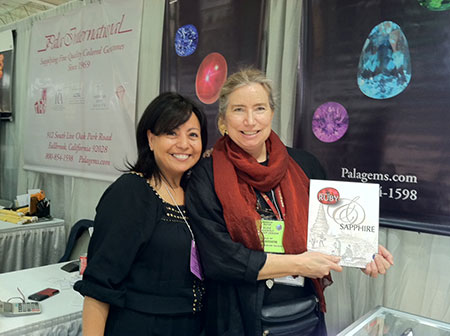 |
| Day one. Pala’s Gabrièl Mattice and The Journal of Gemmology editor Elise Skalwold, at Pala’s AGTA GemFair booth yesterday, with an advance copy of Halford-Watkins’s The Book of Ruby & Sapphire. (Photo courtesy Elise Skalwold) |
11th Annual Westward Look Mineral Show
Pala International and two dozen other world-class mineral dealers shack up at a Sonoran Desert resort.
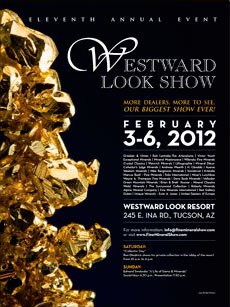 |
- Collector Day (Sat) features Ron Gladnick and selections from his private collection
- Edward Swoboda: “A Life of Gems & Minerals” (Sun) is a rare opportunity to take in a presentation by this 94-year-old legend of the mineral-collecting world. Also on hand will be special guests Wendell Wilson, Bill Larson and Gene Meieran
Event: 11th Annual Westward Look Mineral Show
When: February 3–6, 2012
Where: Westward Look Resort
Suite: 224
See Pala International’s page on the Westward Look Show site.
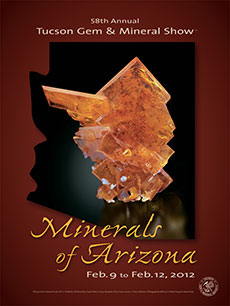 |
58th Annual Tucson Gem and Mineral Show
TGMS is the largest gem and mineral show in the country. This year’s theme is “Minerals of Arizona.”
The symposium and guest speaker schedule is now available here. Jeff Scovil offers a mineral photography seminar on the 9th and the Arthur Roe Memorial Micromount Symposium on the 10th kicks off with Ray Grant’s presentation on collapsed breccia pipes in copper followed by Bob Meyer’s focus on the micro-minerals of Tiger, the ghost town in Arizona’s Pinal County. Harvey Jong will present Bill Hunt’s Arizona micromount treasures. Jong also will talk on 3-D mineral photography, one of his studio’s specialties. John Cesar and Gene Schlepp will look at the Old Yuma Mine, in Saguaro National Monument. Ben Williams’s Bisbee collection—in storage with books and photos for 60 years—will be covered by Evan Jones. Bisbee mines and minerals also will be the subject of Bisbee native Dick Graeme. Les Presmyk will look at Arizona mineral collecting in general and the Globe-Miami district in particular.
The 33rd Annual FM-TGMS-MSA Mineralogical Symposium on the 11th will look at many aspects of the theme “Minerals of Arizona,” chaired by Julian Gray and Raymond Grant. Marcus Origlieri and Raymond Grant will present an overview of the subject—past, present and future, followed by Jim McGlasson’s look at mining before Arizona’s statehood in 1912. The role of Bisbee minerals in gaining that statehood will be presented by Richard Graeme. Wolfgang Mueller will look at Arizona gemstones and Anna Monitor will focus on the Amole District in the Tucson Mountains. The lore of Tombstone will be covered by Peter Megaw. Les Presmyk will talk on “150 years of mining, 100 years of Statehood, 50 years collecting.” The symposium will end with Erik Melchiorre’s talk on Arizona gold.
Event: 58th Annual Tucson Gem and Mineral Show
When: February 9–12, 2012
Where: Tucson Convention Center
Booth: Aisle 5 East
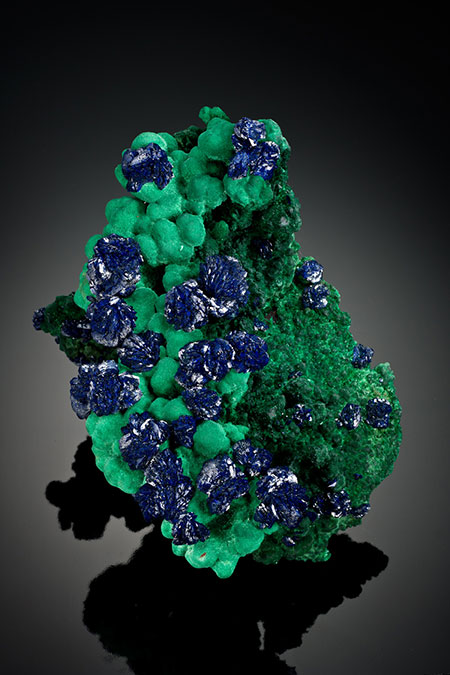 |
| Azurite on malachite. This specimen, from Bisbee, Arizona, will be displayed at TGMS. Bill Larson Collection. Photo: Robert Weldon |
Tucson Transit Tips
Many shows will offer their own shuttles. View your transit and parking options here. [back to top]
Gamini Ratnavira—On the Road and Closer to Home
Painting pairings in Tucson, Carlsbad
Pala International neighbor Gamini Ratnavira was profiled by GIA Insider last month. He discusses his life, inspiration, technique and how he came to live in Southern California. He also can be seen in three streaming videos in which he discusses his family’s relationship with gems and jewelry, and more.
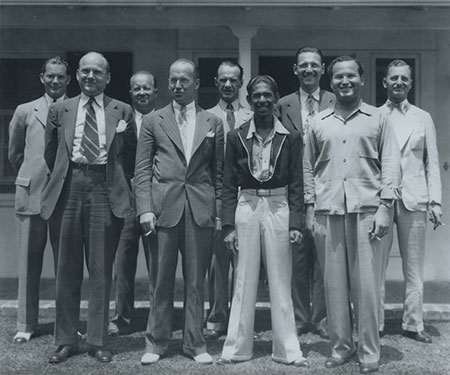 |
| Snazzy. Gamini’s father, Sardha Ratnavira (fourth from right), graduated in 1940 as a member of GIA’s first residence class. (Photo: Bill Larson collection) |
The artist will display his mineral paintings, paired with the specimens they depict, at GIA’s Carlsbad campus in late February (see above link for info). The specimens are from the collection of Ron Gladnick.
Gladnick’s collection—and Ratnavira’s renderings—also will be featured on Collector’s Day at the Westward Look Show, Saturday, February 4, from 10 a.m. to 4 p.m.
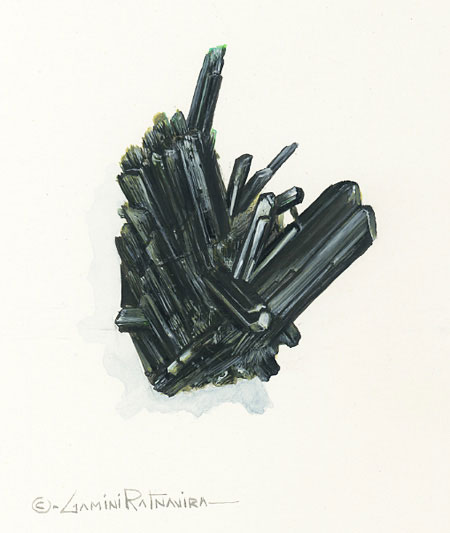 |
| Knappenwand epidote. Gamini’s painting accentuates the character of all the individual crystals of our December 2009 featured specimen, capturing every little face and striation. A little masterpiece to accompany earth’s complex symmetry. (Illustration: Gamini Ratnavira) |
[back to top]
Dallas 2011 DVD
2012 Lineup Includes Larson
Last August’s Dallas Mineral Collecting Symposium was captured on video by BlueCap Productions, which is offering a four-hour DVD of its coverage. The symposium featured Dr. Jeffrey Post (Smithsonian), Dr. Joel Bartsch (Houston Museum of Natural Science), Marc Wilson (Carnegie Museum of Natural History), Judge Francis Allegra (U.S. Court of Federal Claims), Dr. Eugene S. Meieran (Senior Intel Fellow), Dr. George Rossman (Caltech), and Dr. Barbara Dutrow (Louisiana State University). Friends of Pala International get a 10% discount on any BlueCap order. Just enter the code palaintl when you’re asked for it while ordering.
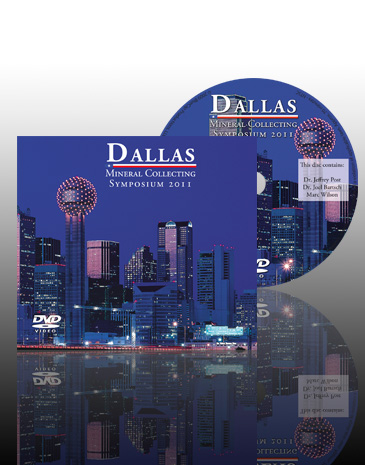 |
The theme of this year’s symposium is “Expeditions to Bring Out Mineral Specimens from Around the World.” Speakers, including Pala’s Bill Larson, will take you from Bisbee to Mogok, and some points in between. See the symposium website for details.
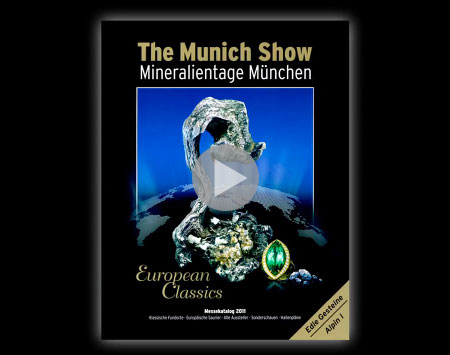 |
| BlueCap’s forthcoming two-hour documentary, What’s Hot In Munich 2011, already has a preview on YouTube. Look for Will Larson’s tennis ball-sized Macedonian ruby at 0:57. The DVD is scheduled for a May 2012 release. |
[back to top]
Pala International News
Pala’s Featured Specimen: Azurite from Arizona
To honor the theme of this year’s TGMS, we exhibit an exquisite azurite crystal from the Bisbee Mine in Arizona. Since we are all halfway out the door, headed to Tucson, not much time to embellish on the specimen. This beauty pretty much speaks for itself. Enjoy, and we’ll see you all at the TGMS and Westward Look Show.
 |
| Arizona azurite. Azurite blade with some malachite replacement. Bill Larson Collection. Price: $3,000 net. Photo: Jeff Scovil, who will conduct a mineral photography seminar at TGMS on February 9 (details here). |
Interested? Call or email us to inquire. [back to top]
And on the blog...
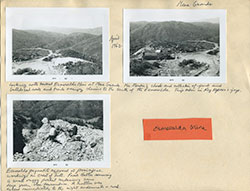 |
On our mining blog we have posted some pages from John Sinkankas’s scrapbook from 1962: a page on the Esmeralda Mine, which Pala currently is operating, and pages and photos of Sinkankas’s visit to the home of California’s state gemstone, benitoite. You’ll want to see a 1930s shot of Mr. Dallas at his cabin in the creek bed just below the San Benito mine.
Visit blog.Palaminerals.com.
[back to top]
Pala to Remain in Tucson
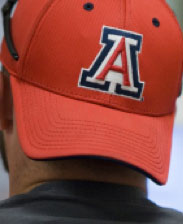 |
(No, we’re not moving; read on...)
Early-birds will get a chance to take in Les Presmyk’s TGMS presentation, “150 years of Mining, 100 years of Statehood & 50 years of Collecting,” this Friday as part of a private reception, lecture and exhibit opening.The University of Arizona Mineral Museum and UA Science: Flandrau are hosting the event in conjunction with “100 Years of Arizona’s Best: The Minerals That Made the State.” (The lecture is repeated at TGMS.)
The time for RSVPing for the Friday event is past, but the exhibit opens to the public the next day, Saturday, February 4; get visit information here. The exhibition will feature hundreds of minerals and gems. Bill Larson remarked that Pala International will have a prominent presence in the show, with specimens on loan for a year. For more background on the show, see the Arizona Daily Star.
While you’re at UA, drop by the Science–Engineering Library and see “Company Town: Arizona’s Copper Mining Communities During 100 Years of Statehood.” The exhibit draws on the UA Special Collections in covering the history of eight Arizona mining communities: Ajo, Bisbee, Clifton-Morenci, Globe-Miami, Jerome, Ray-Sonora, San Manuel and Superior. More information here. [back to top]
Mineral and Mineralogy News
George Bosshart 1943–2012
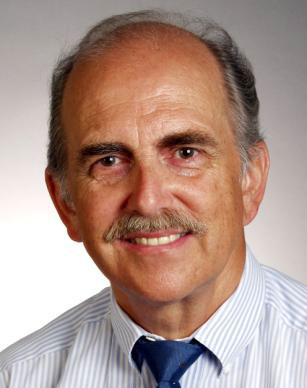 |
We received word last month from Anne Bosshart that her husband George passed away January 14. “Over many years he was fighting cancer and lost in the end. Throughout all his days, his work kept him going and he loved to be with people, all the precious stones and their sources.” Our hearts go out to Anne, whose devoted care of George made it possible for him to remain out of hospital until just a few days before his death. It was such care that allowed George to prepare a study on color stability in spodumene, which he presented at last July’s International Gemmological Conference in Interlaken, Switzerland. He also presented a poster session on “emeraqua.”
George Bosshart had been chief gemologist, Research and Development, at the Gübelin Gem Lab in Lucerne. He made many contributions to gemological science and literature. After his university education in Switzerland, he did some geological fieldwork in Canada. His career in gemology followed, and he became director of SSEF (Swiss Gemmological Institute) for many years, when the lab was located in Zurich. During this time he worked closely with Prof. H. A. Hänni.
George was a close friend of Dr. Karl Schmetzer for nearly forty years. “To his last days he was interested in gems and gemmology,” Dr. Schmetzer told us, “and continued his major research project about green diamonds and the origins of colour, working with his own collection and samples from museums.” He conducted irradiation experiments and compared spectroscopic properties of natural samples with irradiated stones.
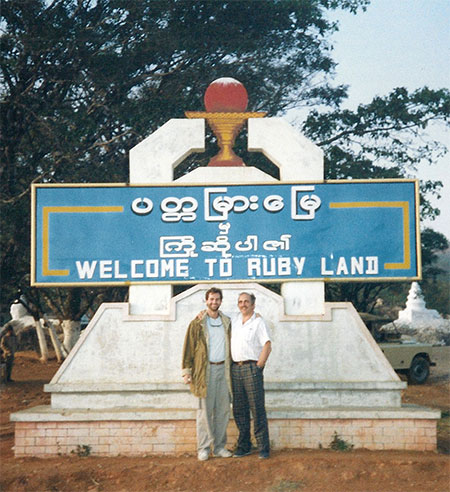 |
| Palling around. George Bosshart, right, with Edward Boehm, at the entrance to Ruby Land. (Photo: Dr. Eduard Gübelin and Edward Boehm) |
Richard W. Hughes shared with George “a love for travel to remote localities, particularly in Burma, and we often found ourselves exploring the same places, albeit at different times.” Anne Bosshart was George’s constant traveling companion, and they loved the jade mines of Upper Burma. “But it wasn't just the jade,” Hughes said. “I think, like myself, that was just a convenient excuse to travel, meet new people and explore new cultures. While certainly a Swiss at heart, he was simultaneously a citizen of the world.” George Bosshart contributed to “Burmese Jade: The Inscrutable Gem” by Hughes and others, archived on Palagems.com.
Pala’s Bill Larson recalled getting to know George personally on their first trip to Mogok, Burma, in 1993 with Dr. Eduard Gübelin. They rode together in the “pain-mobile,” named not after the famous mineralogist and gem dealer, but “so named because we all hit our heads on the metal roof (as we rode in the back of the four wheel drive vehicle—sans shock absorbers—the Burmese assigned us to) on every bump on the eight hour journey from Mandalay.” Out of all in that party, George got the worst gashes, but never complained even though they required medical attention. “He was just so excited to see the Valley of Rubies! He made the trip even more special; we all had the best time with him.”
 |
| Pain-mobile. Hold onto your hat, if you’re lucky enough to have one. Otherwise your pate will be at the mercy of jeep’s metal roof. (Photo: Dr. Eduard Gübelin and Edward Boehm) |
Friends and family said goodbye on January 24 at the Protestant Church of Wädenswil. Consider donating to a charity in George Bosshart’s name: Schweizer Berghilfe (Swiss mountain assistance) or Schweizerischer Verein für das Blindenwesen (Swiss National Association of and for the Blind).
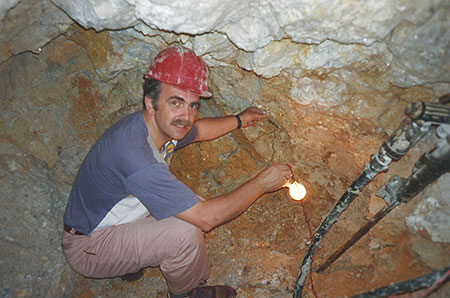 |
| In situ. George Bosshart is in his element here, in Lin Yuang Chi Primary Ruby Mine, Mogok, Burma. (Photo: Dr. Eduard Gübelin and Edward Boehm) |
[back to top]
George Bosshart on Bi-colored Beryl—“Emeraqua”
In November of 2010 Pala International’s Bill Larson was notified by the late George Bosshart of some intriguing crystals.
I have a topic for you, the connoisseur of the Afghanistan-Pakistan and other beryl-producing areas: You cannot be aware of our totally unexpected find of cm-size emerald crystals in the Binntal (the famous mineral paradise in the southwestern Swiss Alps) because we have published the find in a Swiss mineral magazine only (Krzemnicki M. S., Bosshart G.[2003]: Der Binntal-Smaragd als Juwel. Schweizer Strahler, 13, 4, 31-33. ISSN 0370-9213).
The topic has not been published in English.
Certainly it is not the size of the emeralds which is noteworthy but the optical and chemical properties which strongly resemble those of Colombian emeralds and even more so a phenomenon which truly is rare. A few of the longer double-ender crystals are bi-coloured, chromium-green on one and aquamarine-blue on the opposite end. This catapults our tiny babies into a world of their own, the emerald-aquamarines or “emeraquas.”
 |
| A blue to blue-green Habachtal crystal chip. Another, more convincing “emeraqua” chip was sold at the Munich Mineral show 2010 (both pieces not available for analysis). |
Bill Larson replied, “I have seen some of these new Austrian emeralds; some with aquamarine. They are quite unique.” We immediately followed up with Bosshart, asking whether we might publish his remarks. He replied:
Palagems people have never been asleep, just like their big boss. This time, however, I have to pull the brakes. I do not see the urgency for publication or pre-publication of the subject, especially since I have no decent specimens and analytical data. … I will consider sending you a write-up as soon as I have made substantial progress on the topic.
Before George Bosshart’s death, we received an elaboration of his poster session on the subject, which he presented to the 32nd International Gemmological Conference, July 2011, in Interlaken, Switzerland. While we feel the loss of the man, his work endures. In celebration of the life and loves of George Bosshart we are pleased to publish “Do bi-coloured, green and blue beryls exist, which are composed of emerald and aquamarine zones?” [back to top]
Mineral Impossible: Extraterrestrial Quasicrystal
A rock collected in Russia, containing an “impossible” structure, may be older than the Earth, according to an international team publishing January 3 in PNAS, Proceedings of the National Academy of Sciences of the United States of America (available here). The crystalline structure of the mineral was thought not to exist in nature, yet it has been identified as the first natural quasicrystal. Synthetics have been reported since 1984, according to a Princeton University article, and have had industrial applications. The instability of the real world, compared with laboratory conditions, caused experts to dismiss the possibility of their natural existence.
Not all experts agreed, however. Princeton professor Paul Steinhardt, who doubted this assumption, eventually hooked up with mineralogist Luca Bindi of Florence, Italy’s Museum of Natural History, who offered some promising specimens, including a khatyrkite sample. But when that sample arrived, it was damaged to the point that further damage could have caused the remaining microscopic grains to be lost.
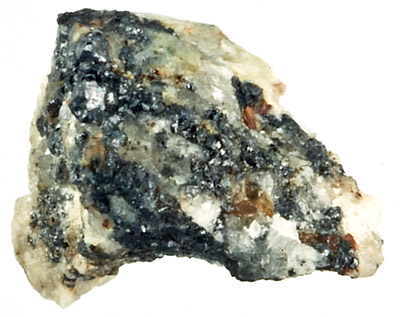 |
| 4.5 billion years young. This sample was collected in Russia’s Koryak Mountains of Russia’s Far-Eastern Region. It contains grains of a quasicrystalline mineral that never before had been seen in nature, leading to the hunch that is a meteorite fragment. (Image courtesy of Luca Bindi) |
The extraterrestrial connection was made after discounting other possibilities, such as the sample having an industrial origin and somehow finding its way into the Italian collection. Eventually the researchers made contact with the original collector, leading them to the locality last summer. New samples are being analyzed. [back to top]
Pala Presents
The Igneous Rocks of the Mogok Stone Tract
Chapter III, Parts 1 & 2, of a PhD Dissertation by Kyaw Thu
With Pala Presents, we offer selections from the library of Pala International’s Bill Larson, who will share with us some of the wealth of information in the realm of minerals and mineralogy.
In this installment, we present Chapter III of Kyaw Thu’s 2007 PhD dissertation, which surveys the petrography of the Mogok Stone Tract’s igneous rocks. He discusses this in seven sections.
- Ultramafic and Mafic Rocks
- Augite-biotite Granite
- Leucogranite
- Syenitic Rocks
- Urtite Series
- Kabaing Granite
- Pegmatites and Aplites
Our next installment will feature Chapter IV Petrochemistry.
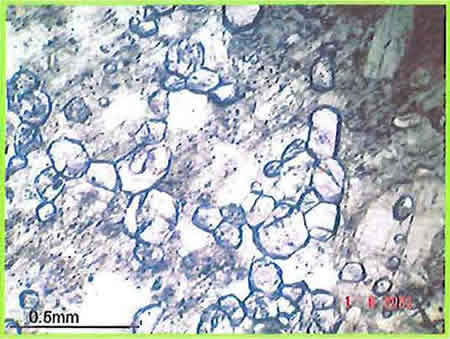 |
| From Figure 3.57. Small corundum grains in ijolite, Thurein Taung, PPL, 25 X. (Photomicrograph: Kyaw Thu) |
[back to top]
— End February Newsletter • Published 2/1/12 —
